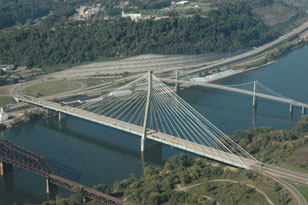
Similar in appearance to the Ohio River crossing at East Huntington more than 200 miles to the south, the cable‑stayed Veterans Memorial Bridge carrying US 22 between Weirton, West Virginia and Steubenville, Ohio is instead a monolith of both concrete and steel, combining the strengths of both.
Under development for three decades, the bridge suffered numerous delays occasioned by new environmental policies, design changes and the search for funding sources for construction that ultimately resulted in a unique combination of money from both states, along with primary, regular bridge and discretionary bridge federal aid to arrive at its final $70 million cost.
Beginning with a preliminary engineering report done for Ohio in 1961 and a route location study done for West Virginia in 1964, through the revelation of an historic site in a 1972 environmental impact statement and a change from toll to public financing that resulted in need for additional public meetings and hearings in 1976-77, the project finally received Federal Highway Administration location and design approval in 1978.
Construction of the Michael Baker-designed structure began in mid-1979 with building of the Ohio River piers by Dravo Corporation. Once the historic Federal Land Office was relocated in 1982, the five contracts remaining were awarded in the mid-’80s to Mashuda Corporation, H.J. Schneider Construction, Inc., National Engineering & Contracting, Inc., Danis Industries Corporation and S.J. Groves & Sons.
Named by a December 1988 Commissioner’s Order, the Veterans Memorial Bridge was opened to traffic on May 1, 1990 by the governors of both states. It provides six 12‑foot lanes on a segmentally constructed deck of steel girders with poured‑in‑place concrete, above which rises a single 360‑foot inverted Y‑shaped concrete tower. Radiating from the tower, 26 paired cables—the longest measuring 800 feet—reach across the 690‑foot West Virginia back span and the 820‑foot main river span to two Ohio approach spans of 314 and 140 feet. Material used in erection of the superstructure included 9 million pounds of structural steel, 3.4 million pounds of reinforcing steel and 15,000 cubic yards of concrete.
Three years later, the final four-lane upgrading of a short segment of US 22 (once considered for inclusion among the original Appalachian Corridor highways) was done from the bridge to a previous segment, completed in 1972, leading to the Washington-Allegheny county line in Pennsylvania. Using $42.5 million in funding made available by West Virginia’s senior senator, Robert C. Byrd, for whom it was later renamed in 1993, the expressway thus became one of the state’s most expensive, totaling more than $125 million for 4.5 miles of roadway and the Veterans Memorial Bridge.
When the bridge was under construction, only three cable-stayed steel girder trusses existed outside of Europe or Japan—in Sitka, Alaska; Luling, Louisiana, and Quincy, Illinois. In the National Steel Bridge Alliance’s 1999 World’s Longest Bridge Spans, the structure still ranked 79th of its type.
Additional West Virginia structures listed by the Alliance include the Chester-Liverpool Bridge in second place and the I-77 Williamstown-Marietta Bridge in 8th place under simple trusses (Highways’ District 3 in Parkersburg claims the I-77 structure is North America’s largest Pennsylvania petit truss) and the William S. Ritchie (Ravenswood) Bridge at Number 7, the Glade Creek at Number 19, Huntington’s Robert C. Byrd (6th Street ) Bridge at Number 28 and the New Martinsville Bridge at Number 29 among continuous trusses. Another list, that of the 1991 World Almanac and Book of Facts, includes the I-64 Dunbar-South Charleston Bridge (tied at Number 26) and Charleston’s 35th Street Bridge (Number 30) under continuous box plate girders.